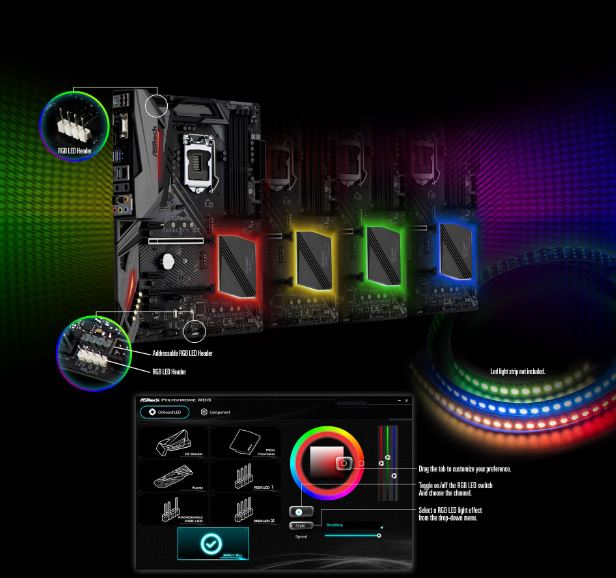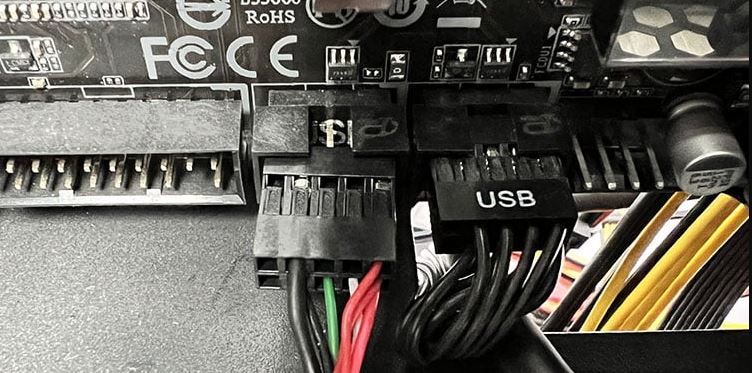If you are familiar with how to build a PC, then you will definitely know what an RGB header on a motherboard is. But if you do not know what it is, then this article is exactly what you need.
An RGB header on a motherboard is a special connector that you can use to connect and control RGB lighting components in your computer system. It’s usually a 3- or 4-pin header on the motherboard designed for specific RGB devices.
It is easier to imagine the RGB header on a motherboard as a connector into which you can plug your lightning devices. The big question becomes, How does the RGB header on the motherboard work? and What can you control with it? Keep reading because this article will cover everything.

What Is The RGB Header On The Motherboard?
The RGB header on the motherboard is a specialized connection portal that allows you to control the lighting on your computer. It also allows you to arrange and personalize them as you see fit.
RGB is an acronym for red, green, and blue colors. These are the primary colors that you can mix up to get any other color you prefer. The RGB header is usually close to the top of the motherboard. It allows you to use the BIOS setting and third-party applications to control lighting effects.
The RGB header on the motherboard controls many devices, such as fans, LED strips, and other RGB-compatible devices. You can synchronize the brightness, colors, and lighting patterns to enhance the beauty of your computer.
Gamers frequently use RGB headers to create distinctive, eye-catching lighting displays that reflect their preferences and style.
How Does the RGB Header On The Motherboard Work?
The RGB header on the motherboard works by providing power and control signals to the lighting devices connected to it. Its pulse-modulated signal controls the lighting strip LED. The RGB header connects to the motherboard through its pin connector. This connector ensures all RGB components work perfectly together.
There are two types of RGB header pin connectors: 12-volt and 5-volt. The major differences between these connectors are the amount of electricity they provide and their RGB data signal transfer mode.
A lot of motherboards have options for the use of both 12-volt and 5-volt RGB headers. But it is important that you first ensure that the header you purchase is compatible with your computer motherboard.
The 12-volt RGB header utilizes a voltage control system, and the 5-volt RGB header uses digital signals to control the lighting system.
Controlling your RGB header is quite easy. You can use your computer motherboard’s BIOS or third-party software like ASUS, Gigabyte, and Corsair to control and adjust the lighting features and effects.
What Type Of RGB Components Can I Use On An RGB Header On The Motherboard?
You can control and customize many RGB components using the RGB header. The options are almost limitless, but the devices depend on your computer’s compatibility. Some common RGB components you can control using an RGB header include the following:
RGB Fans
The RGB header can control RGB fans. These computer fans have RGB lighting that increases the visual aesthetic of your computer’s cooling system.
RGB Led Strips
These are flexible strips that have embedded RGB LEDs. You place them on different parts of your computer case for their beautiful lighting.
RGB CPU Coolers
Some CPU coolers have RGB lighting effects that you can control using an RGB header. These RGB CPU coolers do not only offer a great cooling system; they also increase your PC’s aesthetic.
RGB RAM
Some RAM modules have RGB lighting that you can control using an RGB header on the motherboard.
RGB Keyboard And Mouse
You can also use the RGB header to control the lighting effects on your mouse and keyboard. Although not all mouse and keyboards have RGB effects, some have LED effects that can increase the beauty of your computer.
RGB Lighting Controllers
Some lighting controllers use RGB headers for their control. You can connect and customize your lighting controllers to your preferences.
As much as you can use an RGB header on the motherboard to control many RGB components, you must ensure that these devices are compatible with your motherboard. Check the specifications of both your PC and the RGB components to be sure they will work properly.

What Do I Do If My Computer Has No RGB Header On The Motherboard?
Some computer motherboards do not have an RGB header. This absence can occur on older computers or if you are upgrading your computer. Luckily, there are ways you can manage this problem. So, if your computer has none, you can try the following alternatives:
-
USB RGB Controller
A USB-RGB controller connects to a USB header on your motherboard. This USB header lets you control the lighting effect on any device you want. You only have to plug the RGB device into the USB-RGB controller.
It often has multiple connectors that allow you to connect and control multiple RGB components without using an RGB header. USB-RGB controllers are easy to use and quite cheap.
-
External RGB Controller
Some RGB devices come with their own external controller that you can connect using a USB cable to your PC. These controllers may have their own control software or remote for the lighting effects.
-
Lighting Node Pro
A lighting node pro often controls a Corsair RGB lighting strip. It uses a Corsair IUE connected to a USB header on your computer to do the job.
-
RGB Splitter Cables
An RGB splitter cable can let you control multiple RGB devices with one controller. It uses a cable setup to make this possible. This is another great alternative if you do not have an RGB header on the motherboard.
-
External RGB Lighting Solutions
You can opt for RGB devices that do not require being controlled from the motherboard. These include RGB light strips, LED lamps, and other smart lighting. They can power themselves and provide bright and amazing light effects.
Frequently Asked Questions
What Is The Purpose Of An RGB Header On The Motherboard?
An RGB header on the motherboard serves as a connector that allows you to connect and control RGB lighting components, such as LED strips, fans, and coolers. It provides power and control signals to customize and synchronize the lighting effects of these components.
How Do I Control RGB Lighting Connected To The Motherboard’s RGB Header?
RGB lighting connected to the motherboard’s RGB header can be controlled through manufacturer-provided software, third-party software, or even BIOS settings. These programs allow you to adjust colors, brightness, and lighting patterns to your preferences.
Can I Connect Non-RGB Components To The RGB Header?
No, the RGB header is specifically designed for RGB lighting components. It is not intended for connecting non-RGB devices such as fans or other peripherals. You would have to use other appropriate headers or connectors for non-RGB components.
What Is The Difference Between 4-Pin And 3-Pin RGB Headers?
4-pin RGB headers support standard RGB lighting, where each pin controls one color channel (Red, Green, or blue), and the fourth pin controls the cathode. While 3-pin RGB headers can individually control multiple LEDs, allowing for more complex lighting effects,
Can I Connect Multiple RGB Components To A Single RGB Header?
You can connect multiple RGB components to a single RGB header using splitters or hubs.
What Do I Do If My Motherboard Doesn’t Have An RGB Header?
If your motherboard lacks an RGB header, you can use alternative solutions such as RGB controllers, external RGB controllers, or lighting hubs. You can also use external RGB lighting solutions, such as light strips or lamps.
Conclusion
The RGB header has really changed the aesthetics of computers. You can now customize and control the lighting components on your computer. This amazing fit allows you to be creative and personalize your working tools.
However, you have to ensure that the RGB components are compatible with your computer’s motherboard. If your motherboard has no RGB header, you can use the other alternatives listed in this article.
